Entrepreneurship & Small Business: Ventures, Traits, Economic Impact
VerifiedAdded on 2023/06/12
|10
|3267
|149
Report
AI Summary
This report investigates the scope of entrepreneurial ventures, examining different types such as small, large, and social companies, and differentiating between lifestyle and growth typologies. It explores the traits and characteristics associated with successful entrepreneurship, using Richard Branson and James Dyson as examples, focusing on hard work, motivation, creativity, risk-taking, and innovation. The report defines the 'entrepreneurial mindset' and its associated skills, emphasizing independence, responsibility, and goal orientation. Furthermore, it interprets data and statistics to illustrate the impact of micro and small businesses on the economy, highlighting their role in employment and competition. Finally, the report discusses the differences and similarities between public and corporate intrapreneurship.

Entrepreneurship and
small business
management
small business
management
Paraphrase This Document
Need a fresh take? Get an instant paraphrase of this document with our AI Paraphraser
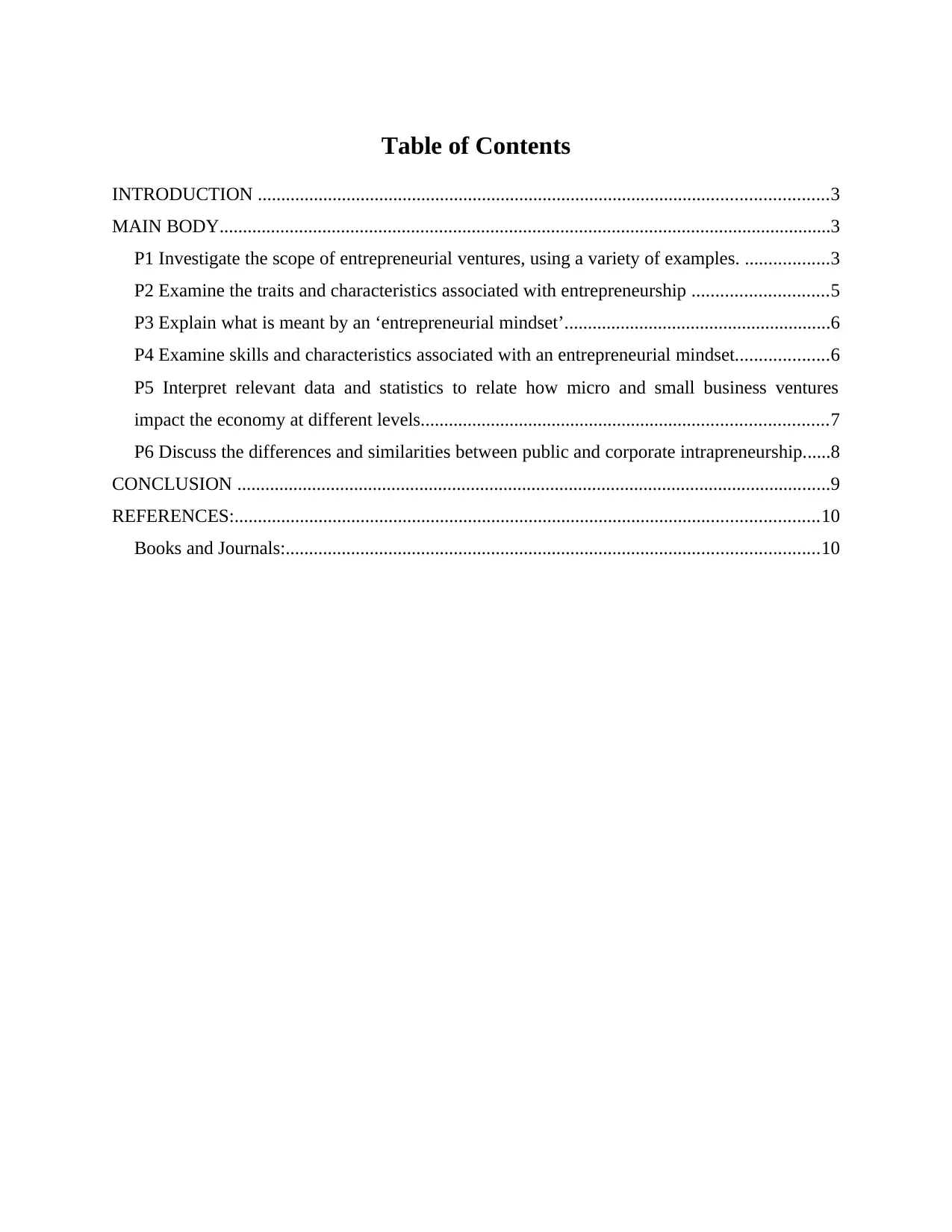
Table of Contents
INTRODUCTION ..........................................................................................................................3
MAIN BODY...................................................................................................................................3
P1 Investigate the scope of entrepreneurial ventures, using a variety of examples. ..................3
P2 Examine the traits and characteristics associated with entrepreneurship .............................5
P3 Explain what is meant by an ‘entrepreneurial mindset’.........................................................6
P4 Examine skills and characteristics associated with an entrepreneurial mindset....................6
P5 Interpret relevant data and statistics to relate how micro and small business ventures
impact the economy at different levels.......................................................................................7
P6 Discuss the differences and similarities between public and corporate intrapreneurship......8
CONCLUSION ...............................................................................................................................9
REFERENCES:.............................................................................................................................10
Books and Journals:..................................................................................................................10
INTRODUCTION ..........................................................................................................................3
MAIN BODY...................................................................................................................................3
P1 Investigate the scope of entrepreneurial ventures, using a variety of examples. ..................3
P2 Examine the traits and characteristics associated with entrepreneurship .............................5
P3 Explain what is meant by an ‘entrepreneurial mindset’.........................................................6
P4 Examine skills and characteristics associated with an entrepreneurial mindset....................6
P5 Interpret relevant data and statistics to relate how micro and small business ventures
impact the economy at different levels.......................................................................................7
P6 Discuss the differences and similarities between public and corporate intrapreneurship......8
CONCLUSION ...............................................................................................................................9
REFERENCES:.............................................................................................................................10
Books and Journals:..................................................................................................................10
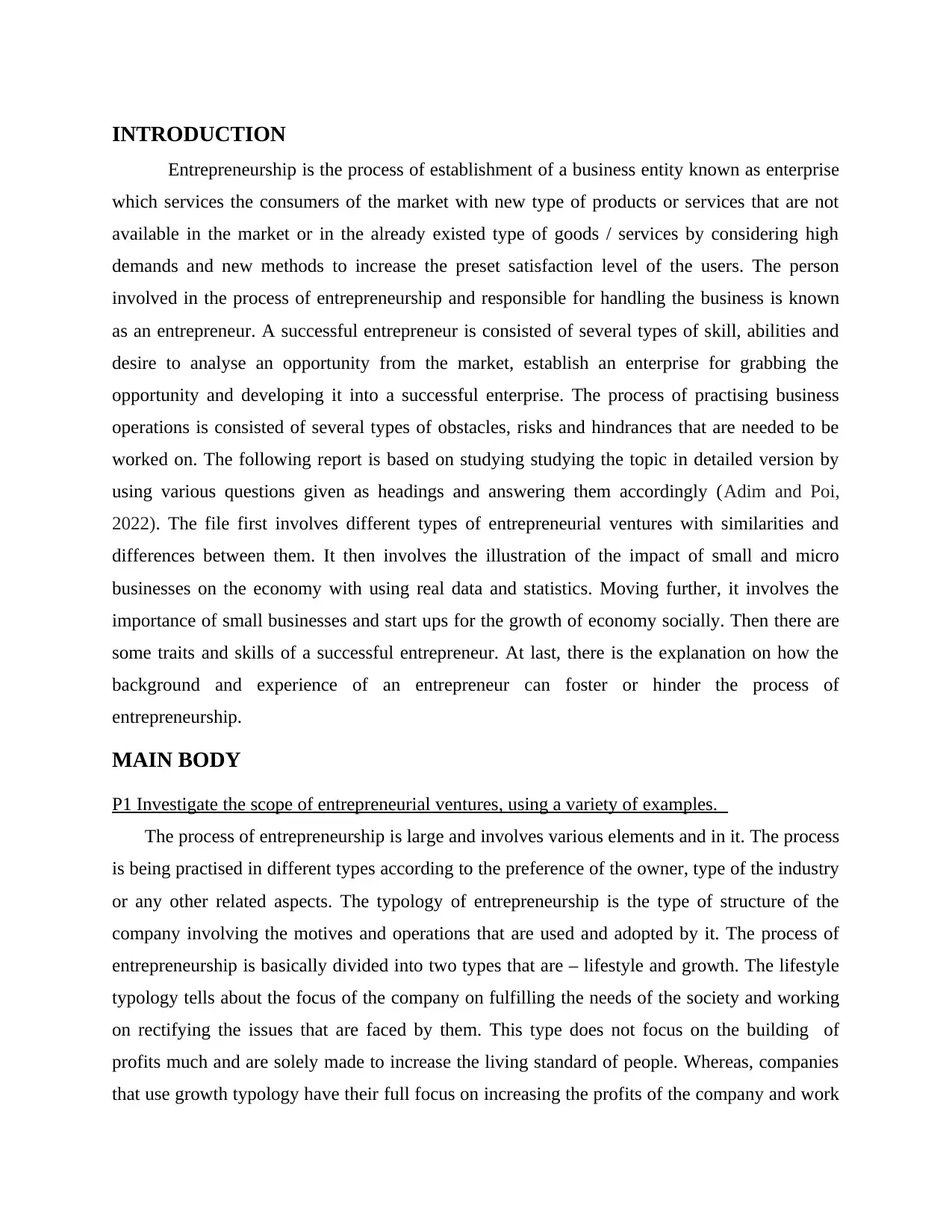
INTRODUCTION
Entrepreneurship is the process of establishment of a business entity known as enterprise
which services the consumers of the market with new type of products or services that are not
available in the market or in the already existed type of goods / services by considering high
demands and new methods to increase the preset satisfaction level of the users. The person
involved in the process of entrepreneurship and responsible for handling the business is known
as an entrepreneur. A successful entrepreneur is consisted of several types of skill, abilities and
desire to analyse an opportunity from the market, establish an enterprise for grabbing the
opportunity and developing it into a successful enterprise. The process of practising business
operations is consisted of several types of obstacles, risks and hindrances that are needed to be
worked on. The following report is based on studying studying the topic in detailed version by
using various questions given as headings and answering them accordingly (Adim and Poi,
2022). The file first involves different types of entrepreneurial ventures with similarities and
differences between them. It then involves the illustration of the impact of small and micro
businesses on the economy with using real data and statistics. Moving further, it involves the
importance of small businesses and start ups for the growth of economy socially. Then there are
some traits and skills of a successful entrepreneur. At last, there is the explanation on how the
background and experience of an entrepreneur can foster or hinder the process of
entrepreneurship.
MAIN BODY
P1 Investigate the scope of entrepreneurial ventures, using a variety of examples.
The process of entrepreneurship is large and involves various elements and in it. The process
is being practised in different types according to the preference of the owner, type of the industry
or any other related aspects. The typology of entrepreneurship is the type of structure of the
company involving the motives and operations that are used and adopted by it. The process of
entrepreneurship is basically divided into two types that are – lifestyle and growth. The lifestyle
typology tells about the focus of the company on fulfilling the needs of the society and working
on rectifying the issues that are faced by them. This type does not focus on the building of
profits much and are solely made to increase the living standard of people. Whereas, companies
that use growth typology have their full focus on increasing the profits of the company and work
Entrepreneurship is the process of establishment of a business entity known as enterprise
which services the consumers of the market with new type of products or services that are not
available in the market or in the already existed type of goods / services by considering high
demands and new methods to increase the preset satisfaction level of the users. The person
involved in the process of entrepreneurship and responsible for handling the business is known
as an entrepreneur. A successful entrepreneur is consisted of several types of skill, abilities and
desire to analyse an opportunity from the market, establish an enterprise for grabbing the
opportunity and developing it into a successful enterprise. The process of practising business
operations is consisted of several types of obstacles, risks and hindrances that are needed to be
worked on. The following report is based on studying studying the topic in detailed version by
using various questions given as headings and answering them accordingly (Adim and Poi,
2022). The file first involves different types of entrepreneurial ventures with similarities and
differences between them. It then involves the illustration of the impact of small and micro
businesses on the economy with using real data and statistics. Moving further, it involves the
importance of small businesses and start ups for the growth of economy socially. Then there are
some traits and skills of a successful entrepreneur. At last, there is the explanation on how the
background and experience of an entrepreneur can foster or hinder the process of
entrepreneurship.
MAIN BODY
P1 Investigate the scope of entrepreneurial ventures, using a variety of examples.
The process of entrepreneurship is large and involves various elements and in it. The process
is being practised in different types according to the preference of the owner, type of the industry
or any other related aspects. The typology of entrepreneurship is the type of structure of the
company involving the motives and operations that are used and adopted by it. The process of
entrepreneurship is basically divided into two types that are – lifestyle and growth. The lifestyle
typology tells about the focus of the company on fulfilling the needs of the society and working
on rectifying the issues that are faced by them. This type does not focus on the building of
profits much and are solely made to increase the living standard of people. Whereas, companies
that use growth typology have their full focus on increasing the profits of the company and work
⊘ This is a preview!⊘
Do you want full access?
Subscribe today to unlock all pages.

Trusted by 1+ million students worldwide
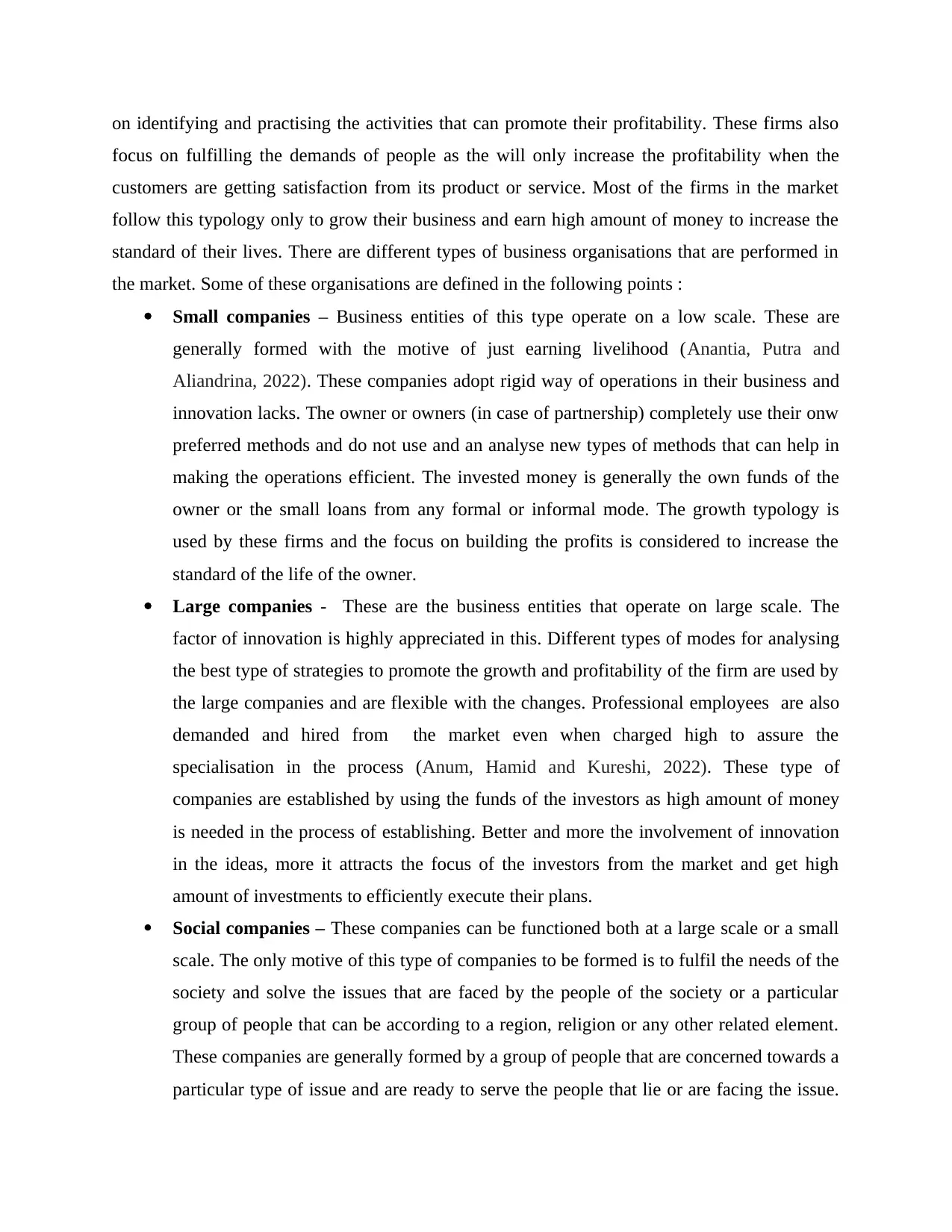
on identifying and practising the activities that can promote their profitability. These firms also
focus on fulfilling the demands of people as the will only increase the profitability when the
customers are getting satisfaction from its product or service. Most of the firms in the market
follow this typology only to grow their business and earn high amount of money to increase the
standard of their lives. There are different types of business organisations that are performed in
the market. Some of these organisations are defined in the following points :
Small companies – Business entities of this type operate on a low scale. These are
generally formed with the motive of just earning livelihood (Anantia, Putra and
Aliandrina, 2022). These companies adopt rigid way of operations in their business and
innovation lacks. The owner or owners (in case of partnership) completely use their onw
preferred methods and do not use and an analyse new types of methods that can help in
making the operations efficient. The invested money is generally the own funds of the
owner or the small loans from any formal or informal mode. The growth typology is
used by these firms and the focus on building the profits is considered to increase the
standard of the life of the owner.
Large companies - These are the business entities that operate on large scale. The
factor of innovation is highly appreciated in this. Different types of modes for analysing
the best type of strategies to promote the growth and profitability of the firm are used by
the large companies and are flexible with the changes. Professional employees are also
demanded and hired from the market even when charged high to assure the
specialisation in the process (Anum, Hamid and Kureshi, 2022). These type of
companies are established by using the funds of the investors as high amount of money
is needed in the process of establishing. Better and more the involvement of innovation
in the ideas, more it attracts the focus of the investors from the market and get high
amount of investments to efficiently execute their plans.
Social companies – These companies can be functioned both at a large scale or a small
scale. The only motive of this type of companies to be formed is to fulfil the needs of the
society and solve the issues that are faced by the people of the society or a particular
group of people that can be according to a region, religion or any other related element.
These companies are generally formed by a group of people that are concerned towards a
particular type of issue and are ready to serve the people that lie or are facing the issue.
focus on fulfilling the demands of people as the will only increase the profitability when the
customers are getting satisfaction from its product or service. Most of the firms in the market
follow this typology only to grow their business and earn high amount of money to increase the
standard of their lives. There are different types of business organisations that are performed in
the market. Some of these organisations are defined in the following points :
Small companies – Business entities of this type operate on a low scale. These are
generally formed with the motive of just earning livelihood (Anantia, Putra and
Aliandrina, 2022). These companies adopt rigid way of operations in their business and
innovation lacks. The owner or owners (in case of partnership) completely use their onw
preferred methods and do not use and an analyse new types of methods that can help in
making the operations efficient. The invested money is generally the own funds of the
owner or the small loans from any formal or informal mode. The growth typology is
used by these firms and the focus on building the profits is considered to increase the
standard of the life of the owner.
Large companies - These are the business entities that operate on large scale. The
factor of innovation is highly appreciated in this. Different types of modes for analysing
the best type of strategies to promote the growth and profitability of the firm are used by
the large companies and are flexible with the changes. Professional employees are also
demanded and hired from the market even when charged high to assure the
specialisation in the process (Anum, Hamid and Kureshi, 2022). These type of
companies are established by using the funds of the investors as high amount of money
is needed in the process of establishing. Better and more the involvement of innovation
in the ideas, more it attracts the focus of the investors from the market and get high
amount of investments to efficiently execute their plans.
Social companies – These companies can be functioned both at a large scale or a small
scale. The only motive of this type of companies to be formed is to fulfil the needs of the
society and solve the issues that are faced by the people of the society or a particular
group of people that can be according to a region, religion or any other related element.
These companies are generally formed by a group of people that are concerned towards a
particular type of issue and are ready to serve the people that lie or are facing the issue.
Paraphrase This Document
Need a fresh take? Get an instant paraphrase of this document with our AI Paraphraser
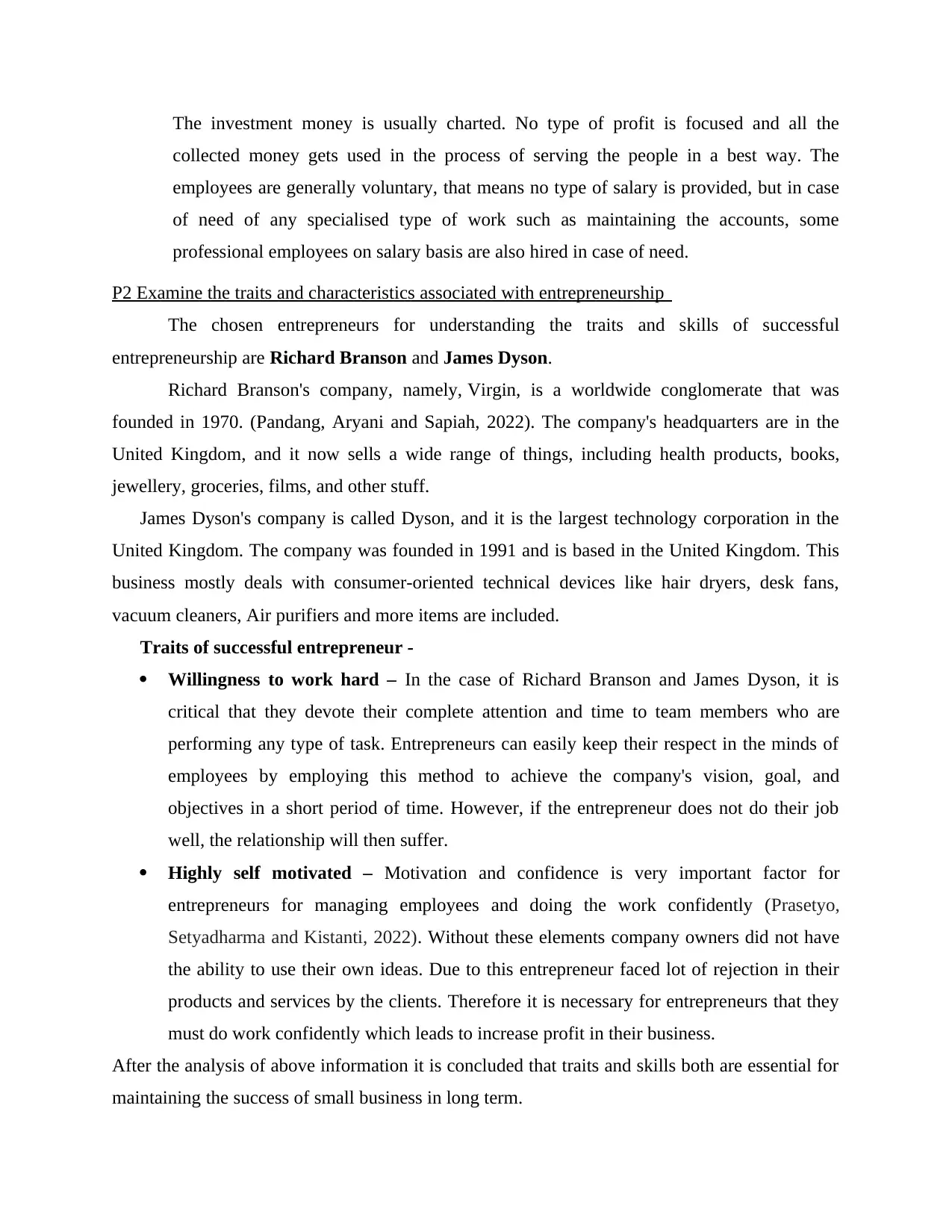
The investment money is usually charted. No type of profit is focused and all the
collected money gets used in the process of serving the people in a best way. The
employees are generally voluntary, that means no type of salary is provided, but in case
of need of any specialised type of work such as maintaining the accounts, some
professional employees on salary basis are also hired in case of need.
P2 Examine the traits and characteristics associated with entrepreneurship
The chosen entrepreneurs for understanding the traits and skills of successful
entrepreneurship are Richard Branson and James Dyson.
Richard Branson's company, namely, Virgin, is a worldwide conglomerate that was
founded in 1970. (Pandang, Aryani and Sapiah, 2022). The company's headquarters are in the
United Kingdom, and it now sells a wide range of things, including health products, books,
jewellery, groceries, films, and other stuff.
James Dyson's company is called Dyson, and it is the largest technology corporation in the
United Kingdom. The company was founded in 1991 and is based in the United Kingdom. This
business mostly deals with consumer-oriented technical devices like hair dryers, desk fans,
vacuum cleaners, Air purifiers and more items are included.
Traits of successful entrepreneur -
Willingness to work hard – In the case of Richard Branson and James Dyson, it is
critical that they devote their complete attention and time to team members who are
performing any type of task. Entrepreneurs can easily keep their respect in the minds of
employees by employing this method to achieve the company's vision, goal, and
objectives in a short period of time. However, if the entrepreneur does not do their job
well, the relationship will then suffer.
Highly self motivated – Motivation and confidence is very important factor for
entrepreneurs for managing employees and doing the work confidently (Prasetyo,
Setyadharma and Kistanti, 2022). Without these elements company owners did not have
the ability to use their own ideas. Due to this entrepreneur faced lot of rejection in their
products and services by the clients. Therefore it is necessary for entrepreneurs that they
must do work confidently which leads to increase profit in their business.
After the analysis of above information it is concluded that traits and skills both are essential for
maintaining the success of small business in long term.
collected money gets used in the process of serving the people in a best way. The
employees are generally voluntary, that means no type of salary is provided, but in case
of need of any specialised type of work such as maintaining the accounts, some
professional employees on salary basis are also hired in case of need.
P2 Examine the traits and characteristics associated with entrepreneurship
The chosen entrepreneurs for understanding the traits and skills of successful
entrepreneurship are Richard Branson and James Dyson.
Richard Branson's company, namely, Virgin, is a worldwide conglomerate that was
founded in 1970. (Pandang, Aryani and Sapiah, 2022). The company's headquarters are in the
United Kingdom, and it now sells a wide range of things, including health products, books,
jewellery, groceries, films, and other stuff.
James Dyson's company is called Dyson, and it is the largest technology corporation in the
United Kingdom. The company was founded in 1991 and is based in the United Kingdom. This
business mostly deals with consumer-oriented technical devices like hair dryers, desk fans,
vacuum cleaners, Air purifiers and more items are included.
Traits of successful entrepreneur -
Willingness to work hard – In the case of Richard Branson and James Dyson, it is
critical that they devote their complete attention and time to team members who are
performing any type of task. Entrepreneurs can easily keep their respect in the minds of
employees by employing this method to achieve the company's vision, goal, and
objectives in a short period of time. However, if the entrepreneur does not do their job
well, the relationship will then suffer.
Highly self motivated – Motivation and confidence is very important factor for
entrepreneurs for managing employees and doing the work confidently (Prasetyo,
Setyadharma and Kistanti, 2022). Without these elements company owners did not have
the ability to use their own ideas. Due to this entrepreneur faced lot of rejection in their
products and services by the clients. Therefore it is necessary for entrepreneurs that they
must do work confidently which leads to increase profit in their business.
After the analysis of above information it is concluded that traits and skills both are essential for
maintaining the success of small business in long term.
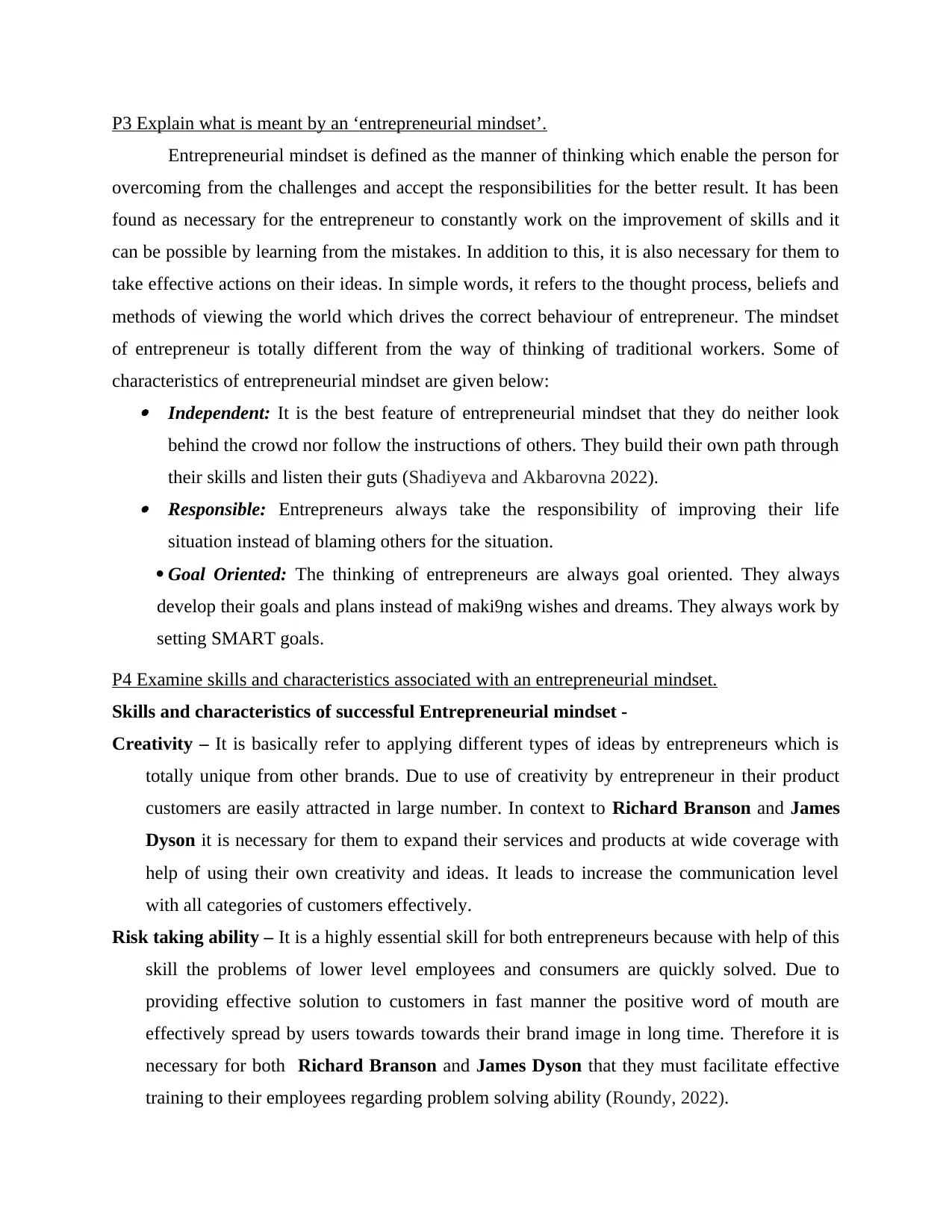
P3 Explain what is meant by an ‘entrepreneurial mindset’.
Entrepreneurial mindset is defined as the manner of thinking which enable the person for
overcoming from the challenges and accept the responsibilities for the better result. It has been
found as necessary for the entrepreneur to constantly work on the improvement of skills and it
can be possible by learning from the mistakes. In addition to this, it is also necessary for them to
take effective actions on their ideas. In simple words, it refers to the thought process, beliefs and
methods of viewing the world which drives the correct behaviour of entrepreneur. The mindset
of entrepreneur is totally different from the way of thinking of traditional workers. Some of
characteristics of entrepreneurial mindset are given below: Independent: It is the best feature of entrepreneurial mindset that they do neither look
behind the crowd nor follow the instructions of others. They build their own path through
their skills and listen their guts (Shadiyeva and Akbarovna 2022). Responsible: Entrepreneurs always take the responsibility of improving their life
situation instead of blaming others for the situation.
Goal Oriented: The thinking of entrepreneurs are always goal oriented. They always
develop their goals and plans instead of maki9ng wishes and dreams. They always work by
setting SMART goals.
P4 Examine skills and characteristics associated with an entrepreneurial mindset.
Skills and characteristics of successful Entrepreneurial mindset -
Creativity – It is basically refer to applying different types of ideas by entrepreneurs which is
totally unique from other brands. Due to use of creativity by entrepreneur in their product
customers are easily attracted in large number. In context to Richard Branson and James
Dyson it is necessary for them to expand their services and products at wide coverage with
help of using their own creativity and ideas. It leads to increase the communication level
with all categories of customers effectively.
Risk taking ability – It is a highly essential skill for both entrepreneurs because with help of this
skill the problems of lower level employees and consumers are quickly solved. Due to
providing effective solution to customers in fast manner the positive word of mouth are
effectively spread by users towards towards their brand image in long time. Therefore it is
necessary for both Richard Branson and James Dyson that they must facilitate effective
training to their employees regarding problem solving ability (Roundy, 2022).
Entrepreneurial mindset is defined as the manner of thinking which enable the person for
overcoming from the challenges and accept the responsibilities for the better result. It has been
found as necessary for the entrepreneur to constantly work on the improvement of skills and it
can be possible by learning from the mistakes. In addition to this, it is also necessary for them to
take effective actions on their ideas. In simple words, it refers to the thought process, beliefs and
methods of viewing the world which drives the correct behaviour of entrepreneur. The mindset
of entrepreneur is totally different from the way of thinking of traditional workers. Some of
characteristics of entrepreneurial mindset are given below: Independent: It is the best feature of entrepreneurial mindset that they do neither look
behind the crowd nor follow the instructions of others. They build their own path through
their skills and listen their guts (Shadiyeva and Akbarovna 2022). Responsible: Entrepreneurs always take the responsibility of improving their life
situation instead of blaming others for the situation.
Goal Oriented: The thinking of entrepreneurs are always goal oriented. They always
develop their goals and plans instead of maki9ng wishes and dreams. They always work by
setting SMART goals.
P4 Examine skills and characteristics associated with an entrepreneurial mindset.
Skills and characteristics of successful Entrepreneurial mindset -
Creativity – It is basically refer to applying different types of ideas by entrepreneurs which is
totally unique from other brands. Due to use of creativity by entrepreneur in their product
customers are easily attracted in large number. In context to Richard Branson and James
Dyson it is necessary for them to expand their services and products at wide coverage with
help of using their own creativity and ideas. It leads to increase the communication level
with all categories of customers effectively.
Risk taking ability – It is a highly essential skill for both entrepreneurs because with help of this
skill the problems of lower level employees and consumers are quickly solved. Due to
providing effective solution to customers in fast manner the positive word of mouth are
effectively spread by users towards towards their brand image in long time. Therefore it is
necessary for both Richard Branson and James Dyson that they must facilitate effective
training to their employees regarding problem solving ability (Roundy, 2022).
⊘ This is a preview!⊘
Do you want full access?
Subscribe today to unlock all pages.

Trusted by 1+ million students worldwide
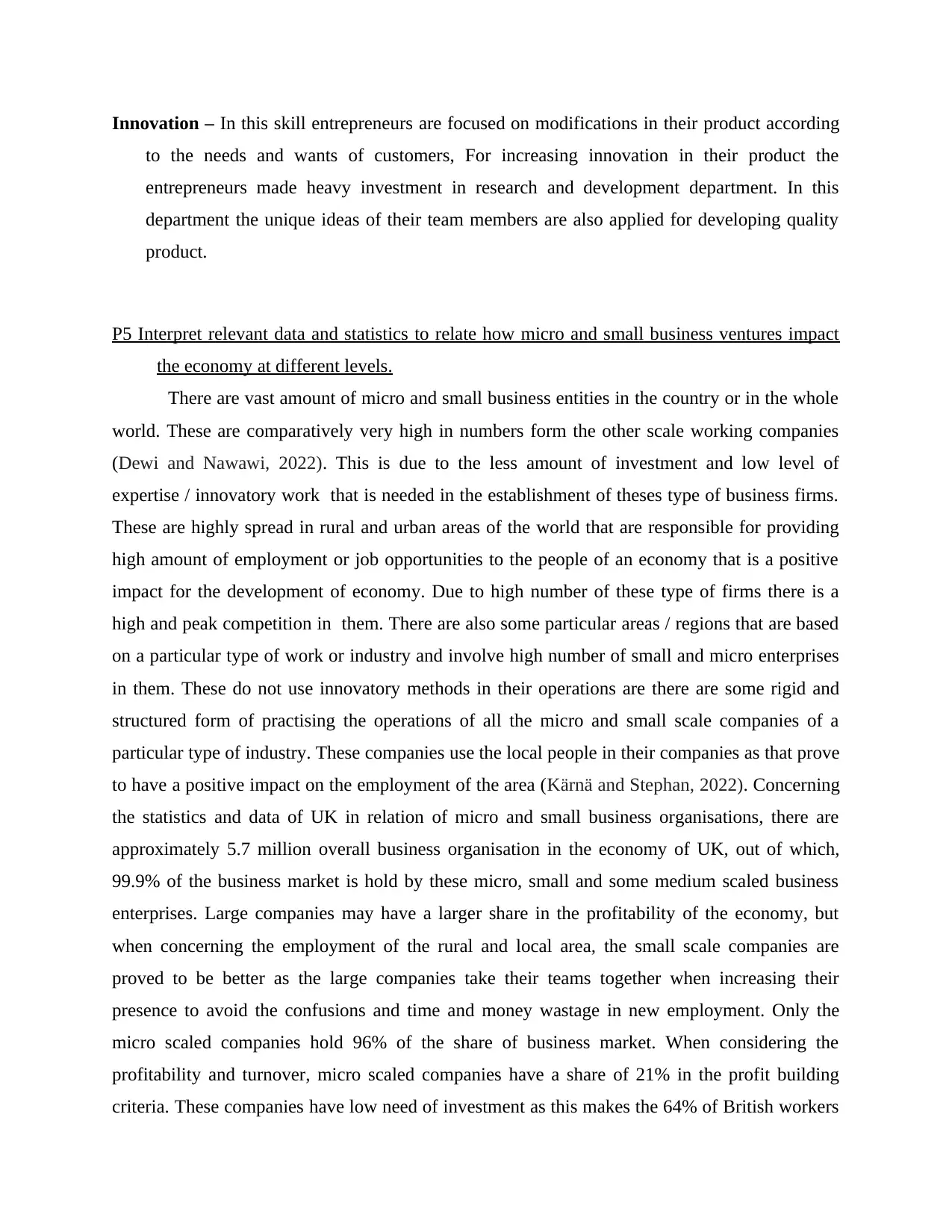
Innovation – In this skill entrepreneurs are focused on modifications in their product according
to the needs and wants of customers, For increasing innovation in their product the
entrepreneurs made heavy investment in research and development department. In this
department the unique ideas of their team members are also applied for developing quality
product.
P5 Interpret relevant data and statistics to relate how micro and small business ventures impact
the economy at different levels.
There are vast amount of micro and small business entities in the country or in the whole
world. These are comparatively very high in numbers form the other scale working companies
(Dewi and Nawawi, 2022). This is due to the less amount of investment and low level of
expertise / innovatory work that is needed in the establishment of theses type of business firms.
These are highly spread in rural and urban areas of the world that are responsible for providing
high amount of employment or job opportunities to the people of an economy that is a positive
impact for the development of economy. Due to high number of these type of firms there is a
high and peak competition in them. There are also some particular areas / regions that are based
on a particular type of work or industry and involve high number of small and micro enterprises
in them. These do not use innovatory methods in their operations are there are some rigid and
structured form of practising the operations of all the micro and small scale companies of a
particular type of industry. These companies use the local people in their companies as that prove
to have a positive impact on the employment of the area (Kärnä and Stephan, 2022). Concerning
the statistics and data of UK in relation of micro and small business organisations, there are
approximately 5.7 million overall business organisation in the economy of UK, out of which,
99.9% of the business market is hold by these micro, small and some medium scaled business
enterprises. Large companies may have a larger share in the profitability of the economy, but
when concerning the employment of the rural and local area, the small scale companies are
proved to be better as the large companies take their teams together when increasing their
presence to avoid the confusions and time and money wastage in new employment. Only the
micro scaled companies hold 96% of the share of business market. When considering the
profitability and turnover, micro scaled companies have a share of 21% in the profit building
criteria. These companies have low need of investment as this makes the 64% of British workers
to the needs and wants of customers, For increasing innovation in their product the
entrepreneurs made heavy investment in research and development department. In this
department the unique ideas of their team members are also applied for developing quality
product.
P5 Interpret relevant data and statistics to relate how micro and small business ventures impact
the economy at different levels.
There are vast amount of micro and small business entities in the country or in the whole
world. These are comparatively very high in numbers form the other scale working companies
(Dewi and Nawawi, 2022). This is due to the less amount of investment and low level of
expertise / innovatory work that is needed in the establishment of theses type of business firms.
These are highly spread in rural and urban areas of the world that are responsible for providing
high amount of employment or job opportunities to the people of an economy that is a positive
impact for the development of economy. Due to high number of these type of firms there is a
high and peak competition in them. There are also some particular areas / regions that are based
on a particular type of work or industry and involve high number of small and micro enterprises
in them. These do not use innovatory methods in their operations are there are some rigid and
structured form of practising the operations of all the micro and small scale companies of a
particular type of industry. These companies use the local people in their companies as that prove
to have a positive impact on the employment of the area (Kärnä and Stephan, 2022). Concerning
the statistics and data of UK in relation of micro and small business organisations, there are
approximately 5.7 million overall business organisation in the economy of UK, out of which,
99.9% of the business market is hold by these micro, small and some medium scaled business
enterprises. Large companies may have a larger share in the profitability of the economy, but
when concerning the employment of the rural and local area, the small scale companies are
proved to be better as the large companies take their teams together when increasing their
presence to avoid the confusions and time and money wastage in new employment. Only the
micro scaled companies hold 96% of the share of business market. When considering the
profitability and turnover, micro scaled companies have a share of 21% in the profit building
criteria. These companies have low need of investment as this makes the 64% of British workers
Paraphrase This Document
Need a fresh take? Get an instant paraphrase of this document with our AI Paraphraser

the desire to have their own business firm. This desire of the workforce is also promoted by the
rigid structure that they have learned at the time of working in their company,
P6 Discuss the differences and similarities between public and corporate intrapreneurship.
Differences among public and corporate intrapreneurship
Public intrapreneurship is defined as the performance of entrepreneurial activities by the
employees in the public companies. It leads to the creation of entrepreneurship within the public
organisation. Whereas the corporate intrapreneurship is refers to the performance of practices of
entrepreneur within the private organisation (Srimulyaniand Hermanto 2022). Here private
organisation is defined as the company in which more than 50% share have been managed and
owned by the government and private organisation is managed by the individuals.
Similarities among public and corporate intrapreneurship
Both Public and Corporate intrapreneurships involve the features and characteristics of
entrepreneur and it is necessary to perform the entrepreneurial activities within the respective
organisation. Both of intrapreneurship involve the system of allowing the employees for acting
like an entrepreneur within the organisation. People who are performing these any of
intrapreneurship are highly motivated and action oriented by nature.
rigid structure that they have learned at the time of working in their company,
P6 Discuss the differences and similarities between public and corporate intrapreneurship.
Differences among public and corporate intrapreneurship
Public intrapreneurship is defined as the performance of entrepreneurial activities by the
employees in the public companies. It leads to the creation of entrepreneurship within the public
organisation. Whereas the corporate intrapreneurship is refers to the performance of practices of
entrepreneur within the private organisation (Srimulyaniand Hermanto 2022). Here private
organisation is defined as the company in which more than 50% share have been managed and
owned by the government and private organisation is managed by the individuals.
Similarities among public and corporate intrapreneurship
Both Public and Corporate intrapreneurships involve the features and characteristics of
entrepreneur and it is necessary to perform the entrepreneurial activities within the respective
organisation. Both of intrapreneurship involve the system of allowing the employees for acting
like an entrepreneur within the organisation. People who are performing these any of
intrapreneurship are highly motivated and action oriented by nature.
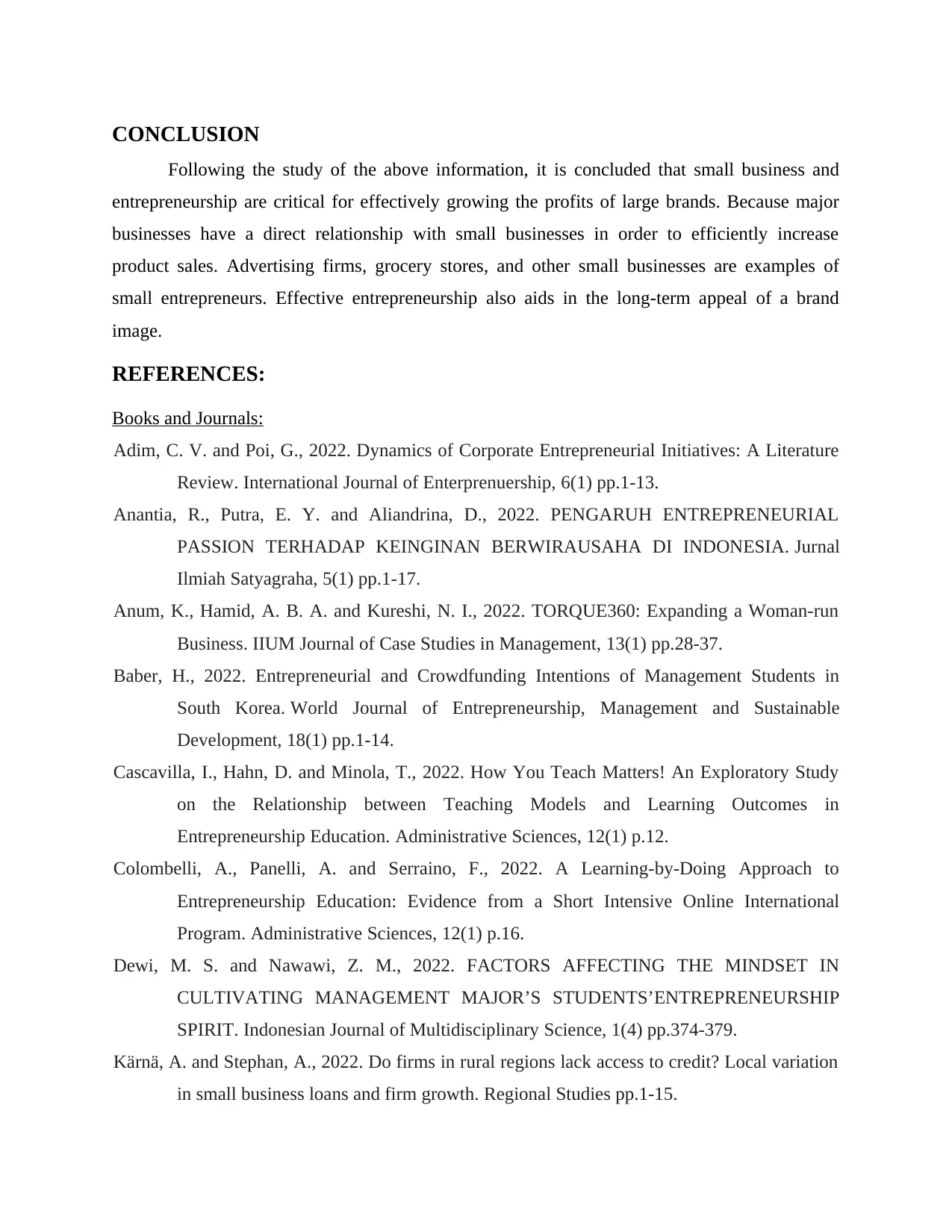
CONCLUSION
Following the study of the above information, it is concluded that small business and
entrepreneurship are critical for effectively growing the profits of large brands. Because major
businesses have a direct relationship with small businesses in order to efficiently increase
product sales. Advertising firms, grocery stores, and other small businesses are examples of
small entrepreneurs. Effective entrepreneurship also aids in the long-term appeal of a brand
image.
REFERENCES:
Books and Journals:
Adim, C. V. and Poi, G., 2022. Dynamics of Corporate Entrepreneurial Initiatives: A Literature
Review. International Journal of Enterprenuership, 6(1) pp.1-13.
Anantia, R., Putra, E. Y. and Aliandrina, D., 2022. PENGARUH ENTREPRENEURIAL
PASSION TERHADAP KEINGINAN BERWIRAUSAHA DI INDONESIA. Jurnal
Ilmiah Satyagraha, 5(1) pp.1-17.
Anum, K., Hamid, A. B. A. and Kureshi, N. I., 2022. TORQUE360: Expanding a Woman-run
Business. IIUM Journal of Case Studies in Management, 13(1) pp.28-37.
Baber, H., 2022. Entrepreneurial and Crowdfunding Intentions of Management Students in
South Korea. World Journal of Entrepreneurship, Management and Sustainable
Development, 18(1) pp.1-14.
Cascavilla, I., Hahn, D. and Minola, T., 2022. How You Teach Matters! An Exploratory Study
on the Relationship between Teaching Models and Learning Outcomes in
Entrepreneurship Education. Administrative Sciences, 12(1) p.12.
Colombelli, A., Panelli, A. and Serraino, F., 2022. A Learning-by-Doing Approach to
Entrepreneurship Education: Evidence from a Short Intensive Online International
Program. Administrative Sciences, 12(1) p.16.
Dewi, M. S. and Nawawi, Z. M., 2022. FACTORS AFFECTING THE MINDSET IN
CULTIVATING MANAGEMENT MAJOR’S STUDENTS’ENTREPRENEURSHIP
SPIRIT. Indonesian Journal of Multidisciplinary Science, 1(4) pp.374-379.
Kärnä, A. and Stephan, A., 2022. Do firms in rural regions lack access to credit? Local variation
in small business loans and firm growth. Regional Studies pp.1-15.
Following the study of the above information, it is concluded that small business and
entrepreneurship are critical for effectively growing the profits of large brands. Because major
businesses have a direct relationship with small businesses in order to efficiently increase
product sales. Advertising firms, grocery stores, and other small businesses are examples of
small entrepreneurs. Effective entrepreneurship also aids in the long-term appeal of a brand
image.
REFERENCES:
Books and Journals:
Adim, C. V. and Poi, G., 2022. Dynamics of Corporate Entrepreneurial Initiatives: A Literature
Review. International Journal of Enterprenuership, 6(1) pp.1-13.
Anantia, R., Putra, E. Y. and Aliandrina, D., 2022. PENGARUH ENTREPRENEURIAL
PASSION TERHADAP KEINGINAN BERWIRAUSAHA DI INDONESIA. Jurnal
Ilmiah Satyagraha, 5(1) pp.1-17.
Anum, K., Hamid, A. B. A. and Kureshi, N. I., 2022. TORQUE360: Expanding a Woman-run
Business. IIUM Journal of Case Studies in Management, 13(1) pp.28-37.
Baber, H., 2022. Entrepreneurial and Crowdfunding Intentions of Management Students in
South Korea. World Journal of Entrepreneurship, Management and Sustainable
Development, 18(1) pp.1-14.
Cascavilla, I., Hahn, D. and Minola, T., 2022. How You Teach Matters! An Exploratory Study
on the Relationship between Teaching Models and Learning Outcomes in
Entrepreneurship Education. Administrative Sciences, 12(1) p.12.
Colombelli, A., Panelli, A. and Serraino, F., 2022. A Learning-by-Doing Approach to
Entrepreneurship Education: Evidence from a Short Intensive Online International
Program. Administrative Sciences, 12(1) p.16.
Dewi, M. S. and Nawawi, Z. M., 2022. FACTORS AFFECTING THE MINDSET IN
CULTIVATING MANAGEMENT MAJOR’S STUDENTS’ENTREPRENEURSHIP
SPIRIT. Indonesian Journal of Multidisciplinary Science, 1(4) pp.374-379.
Kärnä, A. and Stephan, A., 2022. Do firms in rural regions lack access to credit? Local variation
in small business loans and firm growth. Regional Studies pp.1-15.
⊘ This is a preview!⊘
Do you want full access?
Subscribe today to unlock all pages.

Trusted by 1+ million students worldwide

Nguyen, A., Nguyen, P. and Do, H., 2022. The effects of entrepreneurial orientation, social
media, managerial ties on firm performance: Evidence from Vietnamese
SMEs. International Journal of Data and Network Science, 6(1) pp.243-252.
Pandang, A., Aryani, F. and Sapiah, S., 2022. Entrepreneurial Self-Efficacy of Vocational High
School Students in Makassar City. The International Journal of Innovation, Creativity
and Change, 10(11) pp.225-243.
Prasetyo, P., Setyadharma, A. and Kistanti, N., 2022. The role of institutional potential and
social entrepreneurship as the main drivers of business opportunity and
competitiveness. Uncertain Supply Chain Management, 10(1) pp.101-108.
Roundy, P. T., 2022. Technology rewind: The emergence of the analog entrepreneurial
ecosystem. Journal of General Management, 47(2). pp.111-125.
Shadiyeva, G. M. and Akbarovna, G. K., 2022. The Role of Family Business in Increasing
Employment and Welfare of the Population. Journal of Marketing and Emerging
Economics, 1(8), pp.41-45.
Sigar, F. R., Lapian, J. S. and Saerang, R. T., 2022. FACTORS AFFECTING THE SURVIVAL
OF MICRO, SMALL AND MEDIUM ENTERPRISES IN KAKAS DISTRICT. Jurnal
EMBA: Jurnal Riset Ekonomi, Manajemen, Bisnis dan Akuntansi, 10(1), pp.558-569.
Srimulyani, V. A. and Hermanto, Y. B., 2022. Impact of Entrepreneurial Self-Efficacy and
Entrepreneurial Motivation on Micro and Small Business Success for Food and
Beverage Sector in East Java, Indonesia. Economies, 10(1), p.10.
media, managerial ties on firm performance: Evidence from Vietnamese
SMEs. International Journal of Data and Network Science, 6(1) pp.243-252.
Pandang, A., Aryani, F. and Sapiah, S., 2022. Entrepreneurial Self-Efficacy of Vocational High
School Students in Makassar City. The International Journal of Innovation, Creativity
and Change, 10(11) pp.225-243.
Prasetyo, P., Setyadharma, A. and Kistanti, N., 2022. The role of institutional potential and
social entrepreneurship as the main drivers of business opportunity and
competitiveness. Uncertain Supply Chain Management, 10(1) pp.101-108.
Roundy, P. T., 2022. Technology rewind: The emergence of the analog entrepreneurial
ecosystem. Journal of General Management, 47(2). pp.111-125.
Shadiyeva, G. M. and Akbarovna, G. K., 2022. The Role of Family Business in Increasing
Employment and Welfare of the Population. Journal of Marketing and Emerging
Economics, 1(8), pp.41-45.
Sigar, F. R., Lapian, J. S. and Saerang, R. T., 2022. FACTORS AFFECTING THE SURVIVAL
OF MICRO, SMALL AND MEDIUM ENTERPRISES IN KAKAS DISTRICT. Jurnal
EMBA: Jurnal Riset Ekonomi, Manajemen, Bisnis dan Akuntansi, 10(1), pp.558-569.
Srimulyani, V. A. and Hermanto, Y. B., 2022. Impact of Entrepreneurial Self-Efficacy and
Entrepreneurial Motivation on Micro and Small Business Success for Food and
Beverage Sector in East Java, Indonesia. Economies, 10(1), p.10.
1 out of 10
Related Documents
Your All-in-One AI-Powered Toolkit for Academic Success.
+13062052269
info@desklib.com
Available 24*7 on WhatsApp / Email
![[object Object]](/_next/static/media/star-bottom.7253800d.svg)
Unlock your academic potential
Copyright © 2020–2025 A2Z Services. All Rights Reserved. Developed and managed by ZUCOL.





